Today I present to you my 1806 Draped Bust Quarter. It is not in the best of conditions, but considering how pricey these little darlings get, I was lucky to pick this one up from a coin dealer for what I did a while back. This was used to fill in my U.S. type set I am putting together, which is getting down to only a few older and pricier coins now.
The Draped Bust Quarter was minted by the United States Mint from 1796 to 1807. It features a design that is sometimes referred to as Lady Liberty on the obverse. Liberty’s hair looks tied back and she has a draped bust, thus the name given to the coin. The reverse of the coin features an eagle with it's wings outstretched and a shield on its chest. Supposedly the design was originally only created for the half dollar version of the coin but was later used for the quarter as well.


This coin was designed by Robert Scot, who was the chief engraver of the United States Mint from 1793 to 1823. Scot was considered a highly skilled engraver who designed many of the early coins of the United States. Some of these early coins included the Flowing Hair and the Heraldic Eagle design that was used on many of the early American coins. Some say that Scot is an important figure in the history of the United States Mint due to his contributions to early American coinage.
The model for the design of the Draped Bust Quarter is not known with certainty. It is believed that the design was based on a composite of several different women who were prominent in society at the time. Some experts have speculated that the face on the coin may be based on Anne Willing Bingham, who was a wealthy socialite and friend of Thomas Jefferson. However, there is no real evidence to support this claim, and the identity of the model remains a mystery.




The early Draped Bust Quarters minted from 1796 to 1807 were made of a composition of 89.3% silver and 10.7% copper, with a total weight of 6.74 grams (0.1933 troy ounces) and a diameter of 27.5 millimeters. The coin has a reeded edge.


Thanks,
Joe